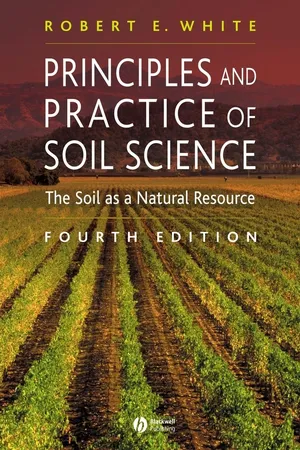
This is a test
- English
- ePUB (mobile friendly)
- Available on iOS & Android
eBook - ePub
Book details
Book preview
Table of contents
Citations
About This Book
Principles and Practice of Soil Science, Fourth Editionprovides a current and comprehensive introduction to soil science for students in the fields of environmental and agricultural science, ecology, soil and land management, natural resource management and environmental engineering.
- Covers all aspects of soil science including soil habitat, processes in the soil environment and soil management.
- Emphasizes the applications of soil science to the solution of practical problems in soil and land management.
- Highlights real world examples drawn from the author's international experience in the field.
- Includes an expanded colour section of soil profiles and other features, and greater coverage of international soil classification
- Features new problem sets and questions at the end of each chapter, designed to reinforce important principles. An answer key is provided at the end of the text.
Frequently asked questions
At the moment all of our mobile-responsive ePub books are available to download via the app. Most of our PDFs are also available to download and we're working on making the final remaining ones downloadable now. Learn more here.
Both plans give you full access to the library and all of Perlego’s features. The only differences are the price and subscription period: With the annual plan you’ll save around 30% compared to 12 months on the monthly plan.
We are an online textbook subscription service, where you can get access to an entire online library for less than the price of a single book per month. With over 1 million books across 1000+ topics, we’ve got you covered! Learn more here.
Look out for the read-aloud symbol on your next book to see if you can listen to it. The read-aloud tool reads text aloud for you, highlighting the text as it is being read. You can pause it, speed it up and slow it down. Learn more here.
Yes, you can access Principles and Practice of Soil Science by Robert E. White in PDF and/or ePUB format, as well as other popular books in Physical Sciences & Organic Chemistry. We have over one million books available in our catalogue for you to explore.
Information
Part 1
The Soil Habitat
‘Soils are the surface mineral and organic formations, always more or less coloured by humus, which constantly manifest themselves as a result of the combined activity of the following agencies; living and dead organisms (plants and animals) parent material, climate and relief.’
‘The soil is teeming with life. It is a world of darkness, of caverns, tunnels and crevices, inhabited by a bizarre assortment of living creatures …’
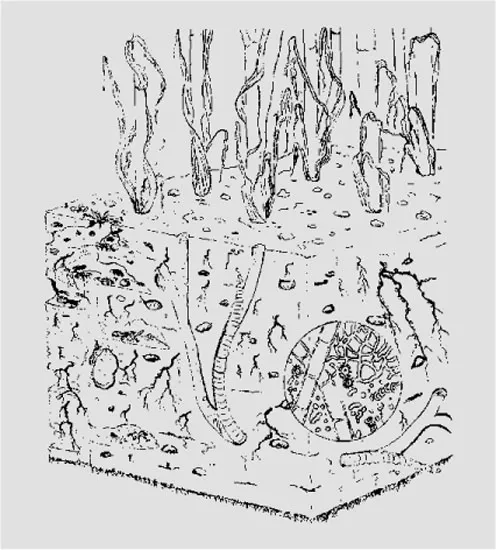
Redrawn from Reganold J. P., Papendick R. I. & Parr J. F. (1990) Sustainable agriculture. Scientific American 262(6), 112–20.
Chapter 1
Introduction to the Soil
1.1 Soil in the making
With the exposure of rock to a new environment – following an outflow of lava, an uplift of sediments, recession of a water body, or the retreat of a glacier – a soil begins to form. Decomposition proceeds inexorably towards decreased free energy and increased entropy. The free energy of a closed system, such as a rock fragment, is that portion of its total energy that is available for work, other than work done in expanding its volume. Part of the energy released in a spontaneous reaction, such as rock weathering, appears as entropic energy, and the degree of disorder created in the system is measured by its entropy. For example, as the rock weathers, minerals of all kinds are converted into simpler molecules and ions, some of which are leached out by water or escape as gases.
Weathering is hastened by the appearance of primitive plants on rock surfaces. These plants – lichens, mosses and liverworts – can store radiant energy from the sun as chemical energy in the products of photosynthesis. Lichens, which are symbiotic associations of an alga and fungus, are able to ‘fix’ atmospheric nitrogen (N2) and incorporate it into plant protein, and to extract elements from the weathering rock surface. On the death of each generation of these primitive plants, some of the rock elements and a variety of complex organic molecules are returned to the weathering surface where they nourish the succession of organisms gradually colonizing the embryonic soil.
A simple example is that of soil formation under the extensive deciduous forests of the cool humid areas of Europe, Asia and North America, on calcareous deposits exposed by the retreat of the Pleistocene ice cap (Table 1.1). The profile development is summarized in Fig. 1.1. The initial state is little more than a thin layer of weathered material stabilized by primitive plants. Within a century or so, as the organo-mineral material accumulates, more advanced species of sedge and grass appear, which are adapted to the harsh habitat. The developing soil is described as a Lithosol (Entisol or Rudosol*). Pioneering micro-organisms and animals feed on the dead plant remains and gradually increase in abundance and variety. The litter deposited on the surface is mixed into the soil by burrowing animals and insects, where its decomposition is hastened. The eventual appearance of larger plants – shrubs and trees – with their deeper roots, pushes the zone of rock weathering farther below the soil surface. After a few hundred more years, a Brown Forest Soil (Inceptisol or Tenosol) emerges. We shall return to the topic of soil formation, and the wide range of soils that occur in the landscape, in Chapters 5 and 9.
1.2 Concepts of soil
The soil is at the interface between the atmosphere and lithosphere (the mantle of rocks making up the Earth’s crust). It also has an interface with bodies of fresh and salt water (collectively called the hydrosphere). The soil sustains the growth of many plants and animals, and so forms part of the biosphere.
* See Box 1.1 for a discussion of soil names.
Fig. 1.1 Stages in soil formation on a calcareous parent material in a humid temperate climate.

Box 1.1 Soil variability, description and classification.
The landscape displays a remarkable range of soil types, resulting from an almost infinite variation in geology, climate, vegetation and other organisms, topography, and the time for which these factors have combined to influence soil formation (human activity is included among the effects of organisms). To bring order to such variety and to disseminate knowledge about soils, soil scientists have developed ways of classifying soils. Individual soils are described in terms of their properties, and possibly their mode of formation, and similar soils are grouped into classes that are given distinctive names. However, unlike the plant and animal kingdoms, there are no soil ‘individuals’ – the boundaries between different soils in the landscape are not sharp. Partly because of the difficulty in setting class limits, and because of the evolving nature of soil science, no universally accepted system of classifying (and naming) soils exists. For many years, Great Soil Group names based on the United States Department of Agriculture (USDA) Classification of Baldwin et al. (1938) (Section 5.3) held sway. But in the last 30 years, new classifications and a plethora of new soil names have evolved (Chapter 14). Some of these classifications (e.g. Soil Taxonomy, Soil Survey Staff, 1999) and the World Reference Base for Soil Resources (FAO, 1998) purport to be international. Others such as The Australian Soil Classification (Isbell, 2002) and the Soil Classification for England and Wales (Avery, 1980) are national in focus. This diversity of classifications creates problems for non-specialists in naming soils and understanding the meaning conveyed by a particular soil name. In this book, the more descriptive and (to many) more familiar Great Soil Group names will be used. Where possible, the approximate equivalent at the Order or Suborder level in Soil Taxonomy (ST) and the Australian Soil Classification (ASC) will be given in parentheses.
There is little merit in attempting to give a rigorous definition of soil because of the complexity of its make-up, and of the physical, chemical and biological forces that act on it. Nor is it necessary to do so, for soil means different things to different users. For example, to the geologist and engineer, the soil is little more than finely divided rock material. The hydrologist may see the soil as a storage reservoir affecting the water balance of a catchment, while the ecologist may be interested only in those soil properties that influence the growth and distribution of plants and animals. The farmer is naturally concerned about the many ways in which soil influences crop growth and the health of his livestock, although frequently his interest does not extend below the depth of soil disturbed by a plough (15–20 cm).
Fig. 1.2 Sites of primitive settlements in the Middle East (after Gates, 1976).
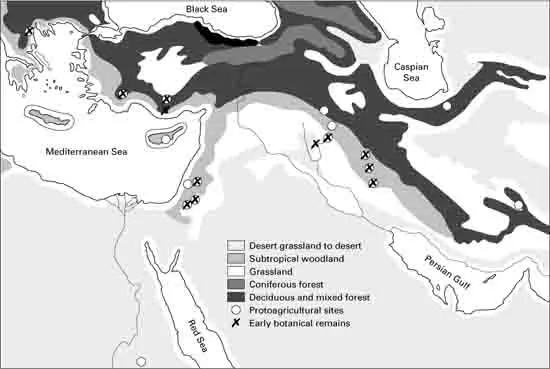
In view of this wide spectrum of potential user-interest, it is appropriate when introducing the topic of soil to readers, perhaps for the first time, to review briefly the evolution of our relationship with the soil and identify some of the past and present concepts of soil.
Soil as a medium for plant growth
Human’s use of soil for food production began two or three thousand years after the close of the last Pleistocene ice age, which occurred about 11,000 years BP (before present). Neolithic people and their primitive agriculture spread outwards from settlements in the fertile crescent embracing the ancient lands of Mesopotamia, Canaan and southern Turkey (Fig. 1.2) and reached as far as China and the Americas within a few thousand years. In China, for example, the earliest records of soil survey (4000 years BP) show how soil fertility was used as a basis for levying taxes on landholders. To study the soil was a practical exercise of everyday life, and the knowledge of soil husbandry that had been acquired by Roman times was passed on by peasants and landlords, with little innovation, until the early 18th century.
From that time onwards, however, the rise in demand for agricultural products in Europe was dramatic. Conditions of comparative peace, and rising living standards as a result of the Indus Revolution, further stimulated this demand throughout the 19th century. The period was also one of great discoveries in physics and chemistry, the implications of which sometimes burst with shattering effect on the conservative world of agriculture. In 1840, von Liebig established that plants absorbed nutrients as inorganic compounds from the soil, although he insisted that plants obtained their nitrogen (N) from the atmosphere: Lawes and Gilbert at Rothamsted subsequently demonstrated that plants (except legumes) absorbed inorganic N from the soil. In the 1850s, Way discovered the process of cation exchange in soil. During the years from 1860 to 1890, emin bacteriologists including Pasteur, Warington and Winogradsky elucidated the role of microorganisms in the decomposition of plant residues and the conversion of ammonia to nitrate.
Fig. 1.3 Soil development in relation to the landscape and underlying regolith.
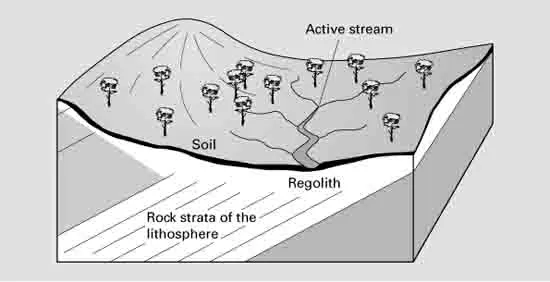
Over the same period, botanists such as von Sachs and Knop, by careful experiments in water culture and analysis of plant ash, identified the major elements that were essential for healthy plant growth. Agricultural chemists drew up balance sheets of the quantities of these elements taken up by crops and, by inference, the quantities that should be returned to the soil in fertilizers or animal manure to sustain growth. This approach, whereby the soil was regarded as a relatively inert medium providing water, mineral* ions and physical support for plants, has been called the ‘nutrient bin’ concept.
* The term ‘mineral’ is used in two contexts: first, as an adjective referring to the inorganic constituents of the soil (ions, salts and particulate matter); second, as a noun referring to specific inorganic compounds found in rocks and soil, such as quartz and feldspars (Chapter 2).
Soil and the influence of geology
The pioneering chemists who investigated a soil’s ability to supply nutrients to plants tended to see the soil as a chemical and biochemical reaction medium. They little appreciated soil as part of the landscape, moulded by natural forces acting on the land surface. In the late 19th century, great contributions were made to our knowledge of soil by geologists who defined the mantle of loose, weathered material on the Earth’s surface as the regolith, of which only the upper 50–150 cm, superficially enriched with organic matter, could be called soil (Fig. 1.3). Below the soil was the subsoil that was largely devoid of organic matter. However, the mineral matter of both soil and subsoil was recognized as being derived from the weathering of underlying rocks, which led to an interest in the influence of rock type on the soils formed. As the science of geology developed, the history of the Earth’s rocks was subdivided into a time scale consisting of eras, periods and epochs, going back some 550 million years BP. Periods within the eras are usually associated with prominent sequences of sedimentary rocks that were deposited in the region now known as Europe. But examples of these rocks are found elsewhere, so the European time divisions have gradually been accepted worldwide (although the European divisions are not necessarily as clear-cut in all cases outside Europe). Studies of the relationship between soil and the underlying geology led to the practice of classifying soils loosely in geological terms, such as granitic (from granite), marly (derived from a mixture of limestone and clay), loessial (derived from wind-blown silt-size particles), glacial (from glacial deposits) and alluvial (from river deposits).
Table 1.1 The geological time scale.
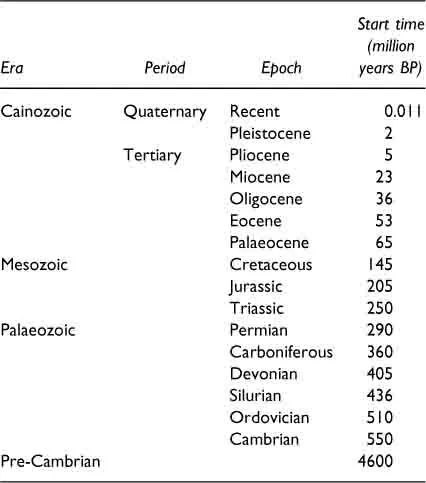
A simplified version of the geological time scale from the pre-Cambrian period to the present is shown in Table 1.1.
The influence of Russian soil science
Russia is a vast country covering many climatic zones in which, at the end of the 19th century, crop production was limited not so much by soil fertility, b...
Table of contents
- Cover
- Contents
- Dedication
- Title Page
- Copyright
- Preface to the Fourth Edition
- Units of Measurement and Abbreviations used in this Book
- Part 1: The Soil Habitat
- Part 2: Processes in the Soil Environment
- Part 3: Soil Management
- Answers to questions and problems
- Index